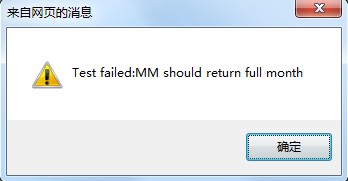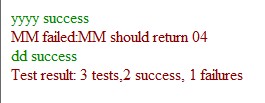JavaScript單元測試ABC
編輯:關於JavaScript
當前,在軟件開發中單元測試越來越受到開發者的重視,它能提高軟件的開發效率,而且能保障開發的質量。以往,單元測試往往多見於服務端的開發中,但隨著Web編程領域的分工逐漸明細,在前端Javascript開發領域中,也可以進行相關的單元測試,以保障前端開發的質量。
在服務器端的單元測試中,都有各種各樣的測試框架,在JavaScript中現在也有一些很優秀的框架,但在本文中,我們將自己動手一步步來實現一個簡單的單元測試框架。
JS單元測試有很多方面,比較多的是對方法功能檢查,對浏覽器兼容性檢查,本文主要談第一種。
本文檢查的JS代碼是我以前寫的一個JS日期格式化的方法,原文在這裡(javascript日期格式化函數,跟C#中的使用方法類似),代碼如下:
復制代碼 代碼如下:
Date.prototype.toString=function(format){
var time={};
time.Year=this.getFullYear();
time.TYear=(""+time.Year).substr(2);
time.Month=this.getMonth()+1;
time.TMonth=time.Month<10?"0"+time.Month:time.Month;
time.Day=this.getDate();
time.TDay=time.Day<10?"0"+time.Day:time.Day;
time.Hour=this.getHours();
time.THour=time.Hour<10?"0"+time.Hour:time.Hour;
time.hour=time.Hour<13?time.Hour:time.Hour-12;
time.Thour=time.hour<10?"0"+time.hour:time.hour;
time.Minute=this.getMinutes();
time.TMinute=time.Minute<10?"0"+time.Minute:time.Minute;
time.Second=this.getSeconds();
time.TSecond=time.Second<10?"0"+time.Second:time.Second;
time.Millisecond=this.getMilliseconds();
var oNumber=time.Millisecond/1000;
if(format!=undefined && format.replace(/\s/g,"").length>0){
format=format
.replace(/yyyy/ig,time.Year)
.replace(/yyy/ig,time.Year)
.replace(/yy/ig,time.TYear)
.replace(/y/ig,time.TYear)
.replace(/MM/g,time.TMonth)
.replace(/M/g,time.Month)
.replace(/dd/ig,time.TDay)
.replace(/d/ig,time.Day)
.replace(/HH/g,time.THour)
.replace(/H/g,time.Hour)
.replace(/hh/g,time.Thour)
.replace(/h/g,time.hour)
.replace(/mm/g,time.TMinute)
.replace(/m/g,time.Minute)
.replace(/ss/ig,time.TSecond)
.replace(/s/ig,time.Second)
.replace(/fff/ig,time.Millisecond)
.replace(/ff/ig,oNumber.toFixed(2)*100)
.replace(/f/ig,oNumber.toFixed(1)*10);
}
else{
format=time.Year+"-"+time.Month+"-"+time.Day+" "+time.Hour+":"+time.Minute+":"+time.Second;
}
return format;
}
這段代碼目前沒有發現比較嚴重的bug,本文為了測試,我們把 .replace(/MM/g,time.TMonth) 改為 .replace(/MM/g,time.Month),這個錯誤是當月份小於10時,沒有用兩位數表示月份。
現在有這麼一句話,好的設計都是重構出來的,在本文中也一樣,我們從最簡單的開始。
第一版:用最原始的alert
作為第一版,我們很偷懶的直接用alert來檢查,完整代碼如下:
復制代碼 代碼如下:
<!DOCTYPE html>
<html>
<head>
<title>Demo</title>
<meta charset="utf-8"/>
</head>
<body>
<script type="text/javascript">
Date.prototype.toString=function(format){
var time={};
time.Year=this.getFullYear();
time.TYear=(""+time.Year).substr(2);
time.Month=this.getMonth()+1;
time.TMonth=time.Month<10?"0"+time.Month:time.Month;
time.Day=this.getDate();
time.TDay=time.Day<10?"0"+time.Day:time.Day;
time.Hour=this.getHours();
time.THour=time.Hour<10?"0"+time.Hour:time.Hour;
time.hour=time.Hour<13?time.Hour:time.Hour-12;
time.Thour=time.hour<10?"0"+time.hour:time.hour;
time.Minute=this.getMinutes();
time.TMinute=time.Minute<10?"0"+time.Minute:time.Minute;
time.Second=this.getSeconds();
time.TSecond=time.Second<10?"0"+time.Second:time.Second;
time.Millisecond=this.getMilliseconds();
var oNumber=time.Millisecond/1000;
if(format!=undefined && format.replace(/\s/g,"").length>0){
format=format
.replace(/yyyy/ig,time.Year)
.replace(/yyy/ig,time.Year)
.replace(/yy/ig,time.TYear)
.replace(/y/ig,time.TYear)
.replace(/MM/g,time.Month)
.replace(/M/g,time.Month)
.replace(/dd/ig,time.TDay)
.replace(/d/ig,time.Day)
.replace(/HH/g,time.THour)
.replace(/H/g,time.Hour)
.replace(/hh/g,time.Thour)
.replace(/h/g,time.hour)
.replace(/mm/g,time.TMinute)
.replace(/m/g,time.Minute)
.replace(/ss/ig,time.TSecond)
.replace(/s/ig,time.Second)
.replace(/fff/ig,time.Millisecond)
.replace(/ff/ig,oNumber.toFixed(2)*100)
.replace(/f/ig,oNumber.toFixed(1)*10);
}
else{
format=time.Year+"-"+time.Month+"-"+time.Day+" "+time.Hour+":"+time.Minute+":"+time.Second;
}
return format;
}
var date=new Date(2012,3,9);
alert(date.toString("yyyy"));
alert(date.toString("MM"));
</script>
</body>
</html>
運行後會彈出 2012 和 4 ,觀察結果我們知道 date.toString("MM")方法是有問題的。
這種方式很不方便,最大的問題是它只彈出了結果,並沒有給出正確或錯誤的信息,除非對代碼非常熟悉,否則很難知道彈出的結果是正是誤,下面,我們寫一個斷言(assert)方法來進行測試,明確給出是正是誤的信息。
第二版:用assert進行檢查
斷言是表達程序設計人員對於系統應該達到狀態的一種預期,比如有一個方法用於把兩個數字加起來,對於3+2,我們預期這個方法返回的結果是5,如果確實返回5那麼就通過,否則給出錯誤提示。
斷言是單元測試的核心,在各種單元測試的框架中都提供了斷言功能,這裡我們寫一個簡單的斷言(assert)方法:
復制代碼 代碼如下:
function assert(message,result){
if(!result){
throw new Error(message);
}
return true;
}
這個方法接受兩個參數,第一個是錯誤後的提示信息,第二個是斷言結果
用斷言測試代碼如下:
復制代碼 代碼如下:
var date=new Date(2012,3,9);
try{
assert("yyyy should return full year",date.toString("yyyy")==="2012");
}catch(e){
alert("Test failed:"+e.message);
}
try{
assert("MM should return full month",date.toString("MM")==="04");
}
catch(e){
alert("Test failed:"+e.message);
}
運行後會彈出如下窗口:

在第二版中,assert方法可以給出明確的結果,但如果想進行一系列的測試,每個測試都要進行異常捕獲,還是不夠方便。另外,在一般的測試框架中都可以給出成功的個數,失敗的個數,及失敗的錯誤信息。
為了可以方便在看到測試結果,這裡我們把結果用有顏色的文字顯示的頁面上,所以這裡要寫一個小的輸出方法PrintMessage:
復制代碼 代碼如下:
function PrintMessage(text,color){
var div=document.createElement("div");
div.innerHTML=text;
div.style.color=color;
document.body.appendChild(div);
delete div;
}
下面,我們就寫一個類似jsTestDriver中的TestCase方法,來進行批量測試:
復制代碼 代碼如下:
function testCase(name,tests){
var successCount=0;
var testCount=0;
for(var test in tests){
testCount++;
try{
tests[test]();
PrintMessage(test+" success","#080");
successCount++;
}
catch(e){
PrintMessage(test+" failed:"+e.message,"#800");
}
}
PrintMessage("Test result: "+testCount+" tests,"+successCount+" success, "+ (testCount-successCount)+" failures","#800");
}
測試代碼:
復制代碼 代碼如下:
var date=new Date(2012,3,9);
testCase("date toString test",{
yyyy:function(){
assert("yyyy should return 2012",date.toString("yyyy")==="2012");
},
MM:function(){
assert("MM should return 04",date.toString("MM")==="04");
},
dd:function(){
assert("dd should return 09",date.toString("dd")==="09");
}
});
結果為:

第四版:統一提供測試數據的批量測試
首先我們添加setUp和tearDown方法:
復制代碼 代碼如下:
testCase("date toString",{
setUp:function(){
this.date=new Date(2012,3,9);
},
tearDown:function(){
delete this.date;
},
yyyy:function(){
assert("yyyy should return 2012",this.date.toString("yyyy")==="2012");
},
MM:function(){
assert("MM should return 04",this.date.toString("MM")==="04");
},
dd:function(){
assert("dd should return 09",this.date.toString("dd")==="09");
}
});
由於setUp和tearDown方法不參與測試,所以我們要修改testCase代碼:
復制代碼 代碼如下:
function testCase(name,tests){
var successCount=0;
var testCount=0;
var hasSetUp=typeof tests.setUp == "function";
var hasTearDown=typeof tests.tearDown == "function";
for(var test in tests){
if(test==="setUp"||test==="tearDown"){
continue;
}
testCount++;
try{
if(hasSetUp){
tests.setUp();
}
tests[test]();
PrintMessage(test+" success","#080");
if(hasTearDown){
tests.tearDown();
}
successCount++;
}
catch(e){
PrintMessage(test+" failed:"+e.message,"#800");
}
}
PrintMessage("Test result: "+testCount+" tests,"+successCount+" success, "+ (testCount-successCount)+" failures","#800");
}
運行後的結果跟第三版相同。
小結及參考文章
上面說了,好的設計是不斷重構的結果,上面的第四版是不是就完美了呢,遠遠沒有達到,這裡只是一個示例。如果大家需要這方面的知識,我後面可以再寫寫各個測試框架的使用。
本文只是JS單元測試入門級的示例,讓初學者對JS的單元測試有個初步概念,屬於拋磚引玉,歡迎各位高人拍磚補充。
本文參考了《測試驅動的JavaScript開發》(個人覺得還不錯,推薦下)一書第一章,書中的測試用例也是一個時間函數,不過寫的比較復雜,初學者不太容易看懂。
作者:Artwl
小編推薦
熱門推薦